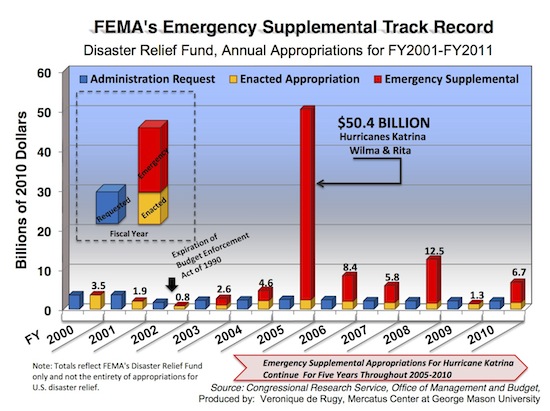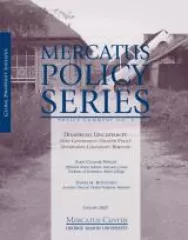- | Government Spending Government Spending
- | Data Visualizations Data Visualizations
- |
Disaster Aid Spending: FEMA’s Track Record
This chart tracks disaster aid spending by the Federal Emergency Management Agency’s (FEMA) Disaster Relief Fund (DRF).
This week Mercatus Center Senior Research Fellow Veronique de Rugy tracks disaster aid spending for the Federal Emergency Management Agency’s (FEMA) Disaster Relief Fund (DRF) using data from the Congressional Research Service (CRS). The chart compares a decade of appropriation requested by the Administration, annual appropriation enacted, and additional emergency supplemental.
Each fiscal year, FEMA and the Office of Management and Budget (OMB) submit a request to the President for the amount of funding the two agencies determine DRF should receive; then the President’s request (blue bars) goes out. We see that the administration’s requests are dramatic underestimations of the actual appropriations enacted and supplemented.
Emergency appropriations bills provide funding that is in addition to what was previously enacted through the regular appropriations process. Such appropriations are exempt from budget allocations and a number of other budget enforcement provisions, thus effectively rendering them off-budget. Despite OMB-proposed guidelines and numerous bills introduced in the House and Senate, Congress has yet to commit itself to an operational definition of the term “emergency.”
The data reveal a considerable increase in supplemental spending since FY 2002 when the Budget Enforcement Act that created spending caps on discretionary spending expired. Since 2004, emergency appropriations exceeded the Administrations requested amount by $370 million to up to $45.7 billion (red bars).
Interestingly, supplemental appropriations continued to make up 55% or more of total enacted appropriations for the DRF each year emergency supplemental were enacted; all of the while White House requested amounts (blue bars) and enacted appropriations (yellow bars) consistently averaged around $2 billion. Not only did DRF appropriations peak at $50.4 billion in 2005, but emergency appropriations for Hurricane Katrina continued for five years after the disaster.
The use of the supplemental process is susceptible to serious abuse that weakens overall budgetary discipline and leads to massive increases in overall spending. The abuse is directly linked to the use of the emergency designation as a large loophole that avoids constraining budget caps and various rules. Reforms should establish clear criteria for emergency spending, require a supermajority vote for emergencies, or establish a reserve fund for emergencies
Veronique de Rugy blogs the abuse of emergency spending at NRO’s The Corner.



